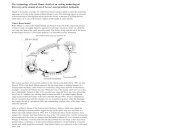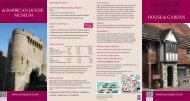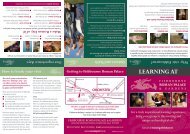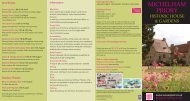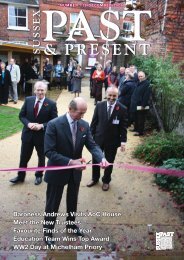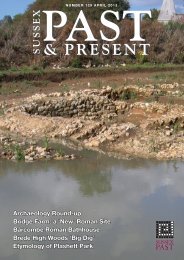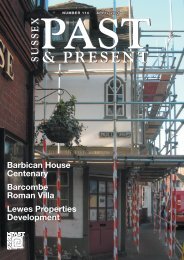April 2011 (issue 123) - The Sussex Archaeological Society
April 2011 (issue 123) - The Sussex Archaeological Society
April 2011 (issue 123) - The Sussex Archaeological Society
You also want an ePaper? Increase the reach of your titles
YUMPU automatically turns print PDFs into web optimized ePapers that Google loves.
Feature<br />
MICHELHAM GARDENS<br />
MICHELHAM GARDENS<br />
Feature<br />
Garden Make-Over at Mich<br />
Medieval monastic gardens recreated at Michelham Priory<br />
ince joining the staff as head<br />
S gardener in September of<br />
2007, I have been conducting<br />
research into medieval gardens as<br />
part of an ongoing programme of<br />
refurbishment and improvement of<br />
the gardens at Michelham Priory.<br />
This research has focussed on the<br />
relationship between the Monastic<br />
life of the Augustinian Canons (the<br />
Priory’s original inhabitants), and the<br />
developing horticultural practices of<br />
the period. It has been undertaken<br />
with a view to improve the way<br />
the history of the Priory gardens<br />
is explained to the visiting public,<br />
and aims to appeal to the more<br />
dedicated horticulturist as well as<br />
someone looking for an interesting<br />
day out in beautiful surroundings.<br />
<strong>The</strong> intended outcome is to include<br />
more of the gardens’ story as part<br />
of the planned reinterpretation of<br />
the Priory.<br />
<strong>The</strong> Priory gardens include three<br />
areas that have been recreated as<br />
medieval style features, these are<br />
the Orchard, the Physic garden and<br />
the Cloister garden. <strong>The</strong> Orchard<br />
and the Physic gardens would have<br />
been essential for the Canons as<br />
they would have been a largely self<br />
sufficient community producing all<br />
their own food and medicinal herbs.<br />
<strong>The</strong> Cloister garden has been built<br />
on the site of the original cloisters<br />
and exhibits some elements of<br />
medieval garden design, planting<br />
and techniques. Unfortunately<br />
there is no surviving documentation<br />
or archaeological evidence to<br />
prove that these features existed<br />
at Michelham when it functioned<br />
as a Priory from 1229 up to its<br />
dissolution in 1536. <strong>The</strong> garden<br />
recreations present today have<br />
been based on existing plans and<br />
documentation from other monastic<br />
sites in Europe, for example the<br />
Benedictine foundation of St Gall in<br />
Switzerland.<br />
<strong>The</strong> Orchard<br />
<strong>The</strong> orchard would have served<br />
as much more than a functional<br />
space for providing fruit. In many<br />
other monastic sites it was used<br />
as a cemetery and in both Persian<br />
and Christian traditions the orchard<br />
was an aspect of paradise. For<br />
the Canons it was a place for<br />
meditation on mortality, death and<br />
rebirth as well as the sustaining<br />
nature of creation. We know that it<br />
is unlikely the orchard was situated<br />
on the island at Michelham as<br />
many canons were buried following<br />
the Black Death in 1348 but their<br />
bodies were never found here.<br />
<strong>The</strong> Orchard.<br />
Photo: S Reid<br />
Today’s orchard consists of<br />
many dessert and cooking apples<br />
planted in lines as its central feature.<br />
<strong>The</strong>se are under planted with wild<br />
daffodils for colour in early spring<br />
and a selection of wild flowers that<br />
continue this decorative display<br />
until late August. Other fruiting<br />
trees in this area include medlars,<br />
mulberries, walnuts, sweet<br />
chestnuts, plums and quince.<br />
Originally these would have been<br />
raised from grafts and from seed in<br />
dedicated beds for each species.<br />
<strong>The</strong>se horticultural techniques<br />
would have passed between the<br />
monasteries throughout Europe<br />
and been studied by the canons.<br />
An example of written evidence<br />
we have of orchards and the stock<br />
available during the medieval<br />
period is included by J Harvey in<br />
his book Medieval Gardens which<br />
gives us an insight into the practical<br />
development of horticulture and the<br />
increasing number of food plants<br />
grown. <strong>The</strong> Westminster Abbey<br />
customary compiled about 1270,<br />
laid upon the monk gardener the<br />
duty of supplying apples, cherries,<br />
plums, pears, nut, and medlars.<br />
<strong>The</strong> painting above shows a<br />
typical orchard set up. On the right<br />
is a nursery of trees behind a wattled<br />
fence, on the left harvesting the<br />
apple crop, in one tree a man beats<br />
down fruit with a stick perhaps for<br />
making verjuice or possibly cider.<br />
In another tree presumably bearing<br />
dessert apples, a man carefully<br />
picks fruit from a tall ladder.<br />
Pictures like these give us a rare<br />
view of how gardens where laid out<br />
in this period as few plans exist.<br />
Harvey’s research also provides<br />
images that show evidence for<br />
design elements and planting<br />
included in the Priory’s cloister<br />
garden.<br />
<strong>The</strong> Cloister Garden<br />
Originally the cloister would<br />
have been at the centre of the<br />
complex linking the church, study,<br />
administration and domestic areas<br />
and would have been used for<br />
procession, study and recreation.<br />
A covered area or walk would have<br />
surrounded an open central area<br />
know as a Garth. Traditionally many<br />
garths were turfed green as the<br />
colour was considered to “refresh<br />
encloistered eyes and the desire to<br />
study returns”.<br />
<strong>The</strong> Cloister garden.<br />
In the cloister at Michelham these<br />
turfed areas are sown with wild<br />
flowers and are the centre piece<br />
for other features documented in<br />
the medieval garden. In one corner<br />
raised beds provide an example of<br />
how physic herbs would have been<br />
grown with one variety per bed. In<br />
another a turf area is enclosed by<br />
raised beds in which vegetables of<br />
the period are displayed. <strong>The</strong> rest<br />
of the cloister is based on medieval<br />
designs of pleasure gardens and<br />
includes decorative plants typical<br />
of the period such as Columbine,<br />
Madonna lilies and the red Gallica<br />
rose. <strong>The</strong>se are then surrounded<br />
by a wooden structure supporting<br />
grape vines that symbolises the<br />
covered walkway.<br />
Harvey’s research provides us<br />
with other images as evidence for<br />
use of these design features and<br />
plantings; for example the picture<br />
(below left) of a small ‘herba’ c1510<br />
shows an enclosed garden that<br />
contains small lawns intersected<br />
by paths. It also includes a clump<br />
of Madonna lilies and a large rose<br />
bush. Outside is a well pit.<br />
<strong>The</strong> Physic Garden<br />
<strong>The</strong> Physic garden is the last of<br />
the medieval gardens at the Priory,<br />
and perhaps the most interesting.<br />
<strong>The</strong> recent discovery of the original<br />
planting scheme, mouse nibbled,<br />
at the back of a dusty cupboard<br />
provided the impetus for a complete<br />
refurbishment of the area, which<br />
began last summer.<br />
<strong>The</strong> history of herbs in the<br />
practice of ‘physic’ or medicine is a<br />
long one. <strong>The</strong> many historical herbal<br />
texts all had as a common base the<br />
knowledge of plants and their uses<br />
acquired by early man, first as hunter<br />
and gatherer, and later as a settled<br />
agriculturalist. By trial and error the<br />
best plants for food and drink, fuel,<br />
dyes, medicine and magic were<br />
discovered. <strong>The</strong> Monastic centres<br />
of Europe were responsible for<br />
preserving the knowledge of herbal<br />
healing through the dark ages. <strong>The</strong><br />
first herb gardens were probably<br />
established in monasteries as early<br />
as 830.<br />
<strong>The</strong> physic garden at Michelham<br />
shows a selection of the plants<br />
which would have been used by an<br />
infirmarer in the practical application<br />
of medicine, or ‘physic’, during<br />
the period when it functioned as a<br />
priory, up to its Dissolution in 1536.<br />
Many plants belong to our native<br />
flora, growing wild in hedgerow and<br />
field. Others, though long familiar<br />
in gardens, were introduced from<br />
Europe and Asia, some by the<br />
Romans, others no doubt through<br />
the visits of British monks to the<br />
Continent as missionaries.<br />
<strong>The</strong> infirmarer of a monastery<br />
would have prepared and<br />
administered all kinds of medicine<br />
to both monks and lay people<br />
including skin and eye ointments,<br />
cordials, purgatives, sedatives,<br />
cough mixtures, air and floor<br />
fresheners and special pot herb<br />
mixtures for convalescents. Herbs<br />
from the garden were supplemented<br />
by common ones collected from the<br />
wild, spare produce being carefully<br />
dried and stored. Each plant had<br />
many applications and all parts<br />
of a plant were used in recipes.<br />
Roots, bark and hard seeds were<br />
pulverised for powders, or soaked<br />
and boiled for a decoction. An<br />
infusion was made by pouring<br />
boiling water over fresh leaves and<br />
flowers and a poultice by pulping<br />
fresh plants with a little water to<br />
bind them into a mass.<br />
<strong>The</strong> Physic Garden.<br />
<strong>The</strong> layout of the Physic garden<br />
is modern, with plants arranged<br />
into groupings according to their<br />
Medicinal uses. During the last<br />
year the more rampant of the plant<br />
species have been controlled and<br />
others that have disappeared<br />
under the onslaught have been<br />
reintroduced. <strong>The</strong> aim is to include<br />
all apart from the most poisonous<br />
of species included in the original<br />
planting. To clarify which plants<br />
belong to which groups each section<br />
has been staked and roped off,<br />
and the plan is to provide signage<br />
detailing one plant species from<br />
each section, with an explanation<br />
of its historic usage.<br />
Stuart Reid<br />
Head Gardener<br />
Michelham Priory<br />
<strong>Sussex</strong> Past & Present <strong>April</strong> <strong>2011</strong><br />
www.sussexpast.co.uk www.romansinsussex.co.uk <strong>Sussex</strong> Past & Present <strong>April</strong> <strong>2011</strong> <br />
Photo: S Reid<br />
Photo: S Reid




